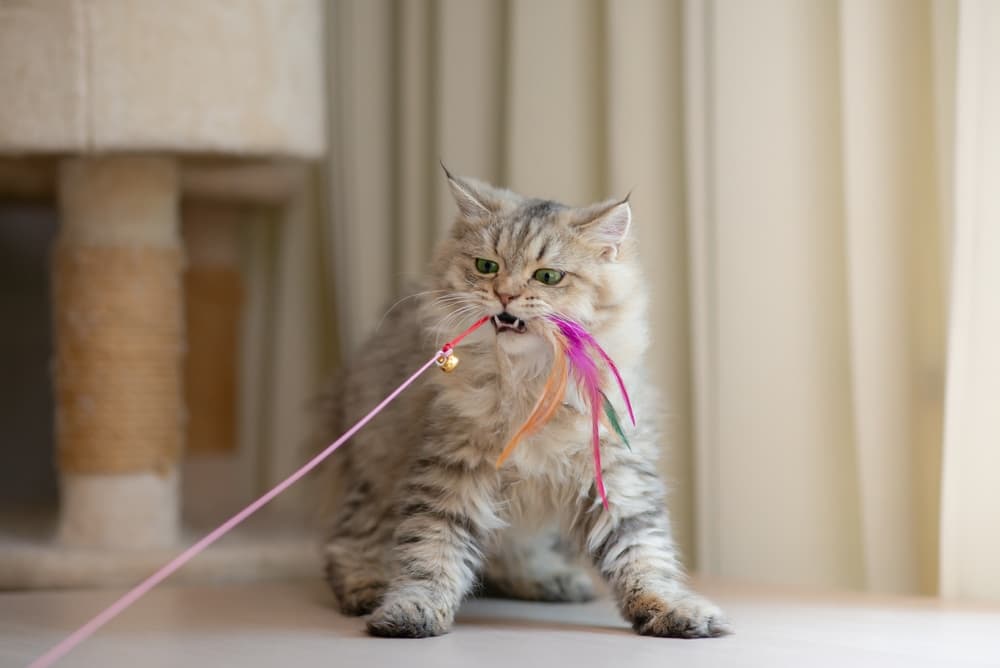Arthritis in Cats: Signs, Causes, and Management

Overview
All featured products are chosen at the discretion of the GreatPetCare editorial team and do not reflect a direct endorsement by the author or reviewer.
Arthritis in cats is notoriously difficult to detect and diagnose. First, cats with arthritis don’t limp the way dogs with arthritis often do. Plus, cats hide any other symptoms they may have so you have to be a pet detective to find the clues.
Even for veterinarians, examining cat’s joints is difficult because cats don’t cooperate. All of that together means that arthritis in cats is severely under-diagnosed and therefore not effectively treated.
The good news is your vet can recommend treatments to help relieve arthritis pain in cats. However, first you need to learn how to detect the subtle signs and what to do about them.
Defining Arthritis in Cats: What Exactly Is It?
When we say arthritis we generally mean osteoarthritis which is painful inflammation of the joints. This is a degenerative disease meaning that it occurs over time and is most likely to be found in older cats. In fact it is estimated that 90 percent of cats over 10 years of age have osteoarthritis in at least one joint.
The way arthritis develops in cats is similar to how it develops in humans and in dogs. Over time, normal wear and tear on the joint surfaces of bones causes inflammation which further degrades the joint surfaces. The body responds by trying to replace injured or damaged bone but this replacement is not as smooth as the original joint surface and creates more inflammation.
Causes of Arthritis in Cats
Osteoarthritis in cats is divided into two categories: primary and secondary. Primary arthritis is due to normal wear and tear over a lifetime. Secondary arthritis is the result of joint degeneration following trauma, injury, or poor conformation. Secondary arthritis can occur at any age.
Munchkin cats, Scottish Folds, and other cats with abnormal physical conformation are at increased risk for developing arthritis.
Cats who are overweight are at increased risk for developing arthritis and at a younger age. This is because excess weight puts excess strain on joints and that speeds the normal wear and tear processes. Excess fat also causes inflammation which is the source of pain in arthritis.
Diseases that cause loss of muscle mass such as diabetes, hyperthyroid disease, and kidney disease can also cause arthritis. Muscles keep weight off of joints which is why exercise is important in preventing arthritis.
Cat Arthritis Symptoms

Symptoms of arthritis in cats are generally less obvious than arthritis in dogs. They involve loss of mobility such as eating or drinking less because it is painful to walk to the food bowl. Cats may no longer be able to reach their favorite napping spots on top of furniture or they may be reluctant to follow you up and down the stairs.
Some cats may groom themselves less or stop grooming all together which is noticeable as a greasy or flaky coat. Usually the first places this becomes noticeable are the lower back and around the anus.
Peeing or pooping outside the litter box can be a sign of arthritis because cats with arthritis may have difficulty stepping in or out of the box or posturing to urinate and defecate.
Cat arthritis symptoms to watch for include:
- Stiffness, especially after sleeping or resting
- Decreased activity
- Not jumping to places they used to be able to reach
- Not playing with their favorite toys
- Changes in litter box use or going outside the litter box
- Decreased grooming
- Decreased eating and drinking
- Limping
- Increased hiding or sleeping
- Less interaction
Diagnosing Cat Arthritis
Veterinarians diagnose cat arthritis through the information you provide, a physical examination, and sometimes X-ray images.
The information you provide about changes in your cat’s behavior is important in diagnosing arthritis in cats because cats do not always acknowledge their pain on a physical exam or may not cooperate for a thorough exam.
During the physical exam your veterinarian will feel along the spine and along the cat’s arms and legs. Your veterinarian will move the joints through their normal ranges of motion to detect any decreases or abnormal movements that may indicate arthritis.
To confirm arthritis your veterinarian may take X-rays (radiographs) of any joints that seem painful or are not able to move well. X-rays are useful to eliminate other causes of pain such as tumors or a bone infection.
Cat Arthritis Treatment

Unfortunately, there are limited available treatments for cats with arthritis which is why prevention is the best medicine. There is no cure for arthritis, only management.
One of the most important components of management is weight loss for overweight cats diagnosed with arthritis. Your veterinarian can help you design a healthy diet to help your cat slowly lose excess weight that contributes to the development and progression of arthritis.
For cats who do have arthritis, a multi-modal management plan is most effective. This includes pain medication, adaptations to the home, and adjunctive or complementary therapies such as physical therapy and acupuncture.
Pain Control
Pain control is an important component of managing arthritis in cats, but it is important to remember that pain control does not treat arthritis, it only reduces its symptoms. There are two categories of pain control that can be useful: non-steroidal anti-inflammatories (NSAIDs) and pain relievers.
NSAIDs minimize pain and inflammation associated with osteoarthritis in cats. They are often most effective in the early stages of arthritis. There are two NSAIDs vets may recommend to treat pain in cats: Meloxicam and Onsior. However neither is specifically approved to treat arthritis. And because cats tend to be more sensitive to the side effects of these drugs, they are generally not recommended for long-term use in cats.


The other category of pain control includes medications that reduce the perception of pain. These include gabapentin and buprenorphine. But, again, neither one is specifically labeled for use in arthritis treatment.


If your veterinarian prescribes either of these types of pain medication to help ease your cat’s arthritis pain, follow their dosing instructions closely. And call them immediately if your cat experiences any side effects, such as vomiting, diarrhea, bloody stool, lethargy, or reduced appetite.
In 2022, a new drug was introduced for the treatment of arthritis in cats. Solensia (frunevetmab) is an injectable antibody treatment that counteracts nerve growth factor (NGF) in cats. NGF is an inflammatory signal that contributes to pain and inflammation in arthritis. By counteracting NGF, Solensia injections decrease pain and inflammation in cats with arthritis. Solensia injections are given once monthly in the veterinary hospital.
Adaptations at Home
Making changes at home can help your cat be more comfortable and can go a long way to reducing symptoms. These include giving your cat a soft, padded or orthopedic bed that is easy to get in and out of, providing a ramp or short steps to places she likes to rest, and making other simple changes to help your cat get around better.
A litter box with one low side helps arthritic cats get in and out easier. You can reduce the need for your cat to use the stairs by keeping everything she needs on one floor of your house where your cat prefers to spend the most time.
Arthritis can reduce a cat’s desire or ability to groom herself. You can help by grooming her frequently with a soft brush, trimming her nails if she is not keen on using the scratching post, and wiping her anus with baby wipes if she is unable to clean it herself. Cats enjoy being clean, so don’t underestimate the value of these changes to her comfort.
Physical Therapy and Other Treatments
Physical therapy is available for cats to help restore muscle mass and address any limping caused by injury or arthritis. Of course, cats have to be willing participants to benefit from most structured types of physical therapy. But even modified exercises at home can be effective. So even if you don’t think your cat will tolerate going to the veterinary physical therapist, the tools and exercises they offer can be useful at home.
Other tools to manage the pain of arthritis include acupuncture and cold laser therapy. Adequan is an injectable supplement that may help rebuild joint cartilage. Stem cell therapy is still in his initial phases but may prove effective in restoring joint health. These can be performed in your veterinarian’s office and many cats tolerate the treatments well.
In rare situations surgery can be beneficial for cats severely impacted by arthritis pain. Surgery may involve removing scar tissue due to a previous injury, may address poor joint positioning, or may require amputation of a very arthritic limb. Surgery is the treatment of last resort for arthritis in cats.
Cost to Treat Arthritis in Cats
The cost to treat arthritis in cats varies depending on which options you and your veterinarian decide are right for your cat. Medications and supplements may each cost between $30 and $100 per month. Adjunctive treatments or therapy may cost $50-$100 per session.
Generally treatments are continued for the rest of the cat’s life since arthritis is a progressive disease.
How to Prevent Arthritis in Cats

Arthritis in cats cannot be fully prevented but there are steps you can take to reduce your feline’s risk and minimize the impact that arthritis has on their quality of life.
The first and most important things are to keep your cat at a healthy weight her whole life and encourage exercise through play.
Regular check-ups with a veterinarian including both physical exams and routine blood work can help prevent arthritis by addressing any diseases that increase arthritis risk. Your veterinarian is trained to notice changes in your cat before you do and she may detect decreased mobility before it becomes painful arthritis.
Many cat joint supplements are best used to slow the development or progression of arthritis. The chondroprotective (joint cartilage support) supplements are slow-acting and can take several weeks to build up to effective levels in the body. These include glucosamine and chondroitin as well as anti-inflammatory supplements such as omega-3 fatty acids (fish oil).



Glucosamine and chondroitin sulfate (with MSM – methyl sulfonyl methane) may take 4-6 weeks to see effect and is not effective for late stage disease. Similarly, omega-3 fatty acids are anti-inflammatory and are best used to reduce arthritis risk or slow its progression. It may take 4 weeks to see the effect. Omega-3 fatty acids have other beneficial effects including heart and skin support and is one of the most well studied supplements available.
Cats are very sensitive, so it is not recommended to use supplements unless you have discussed them with your veterinarian. Just because something is safe and effective for people does not mean it is safe or effective for cats.









